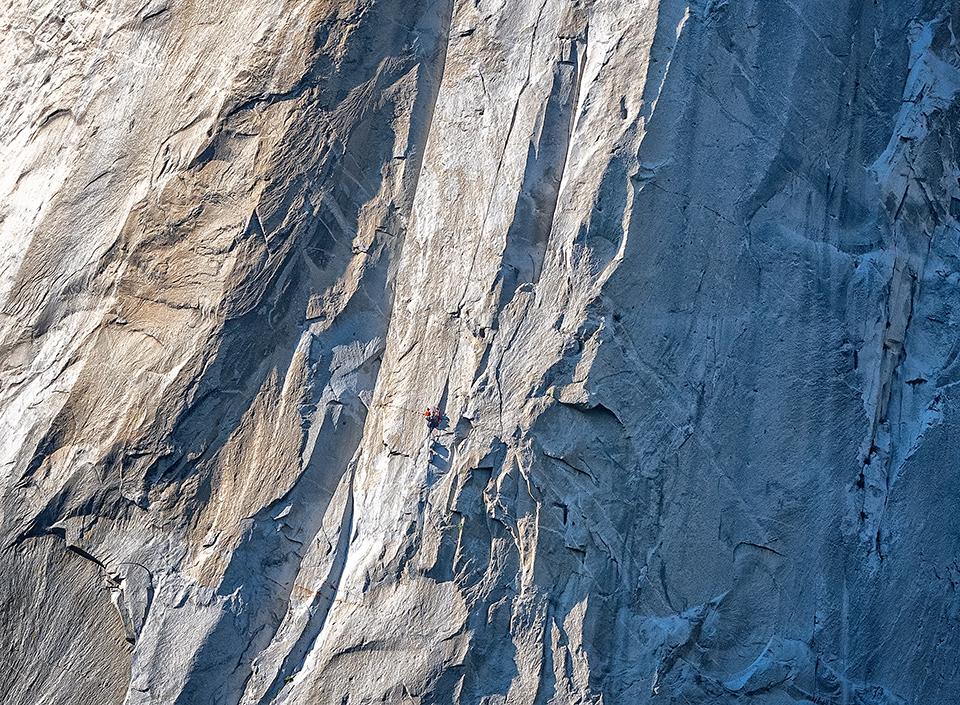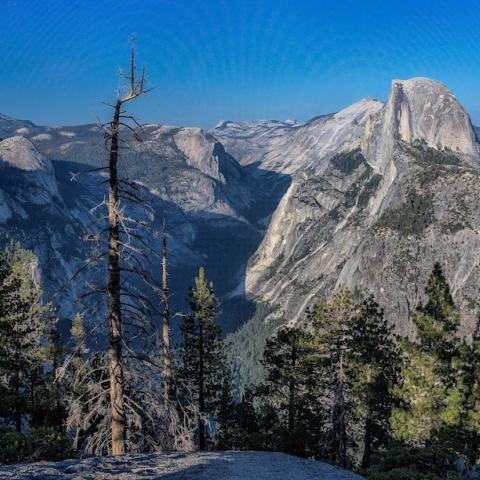
A hazy sunrise at Tunnel View, Yosemite National Park / Rebecca Latson
When someone mentions Yosemite National Park, do you envision a meadow-and-tree-filled valley surrounded by the great granite formations of Half Dome and El Capitan, with waterfalls flowing from tremendous heights and rock climbers hugging those sheer granite cliffs? This national park is all of that, and more. Yosemite is a large park (“almost 1,200 square miles”) with so much to do and see that it’s possible I’ll have missed an item or two with this particular checklist. That said, maybe you’ll see something here you might have forgotten to add to your own planning list.
How will you get there? During the pandemic, driving to the park worked best for me and I didn’t need to worry about luggage limits. Gassing up the SUV in California, however, cost anywhere from $4.69 to over $5.44/gallon. Plus, the drive from my home in central Washington state to my first night’s stay in El Portal took over 15 hours. I’m still glad I drove, but if you can’t see doing a long road trip and would rather take the plane, there are a number of airports into which you can fly, then rent a car to access the park. Oh, and speaking of renting a car, reserve yours way ahead of time to avoid running into a situation of rental scarcity.
Click here to check out the other transportation modes besides flying or driving into Yosemite. Once you are there, consider the in-park shuttle service - except for 2021 – in-park shuttles are not operating this year.
If you drive, your vehicle needs gas … or an electric charging station. While there are no gas stations in Yosemite Valley, there are two gas stations within the park (Wawona, Crane Flat) as well as gas stations in El Portal and Lee Vining, just outside of Yosemite. And, according to an October 2020 article at myyosemitepark.com, there are ev (electric vehicle) charging stations in and around the park.
Depending upon when you plan to visit, you may need to book a day-use reservation in advance to be able to enter the park. Currently for the 2021 season, reservations are required through September 30th in an effort “to better manage heavy visitation … during the COVID-19 pandemic.” A reservation is good for three days and can be purchased via recreation.gov and you’ll need to show proof of your recreation.gov day-use reservation. If you are staying at lodging within the park, including private lodging or a vacation rental, you don’t need to book a reservation, but you must show proof of whatever in-park lodging you have. For more about the park’s reservation system, click here. If you are planning a trip to Yosemite in 2022, then keep an eye on the park’s website. After September 2021, park officials “will re-evaluate the need for the [reservation] system based on public health guidance.”
There’s plenty of lodging both within and outside of the park, including hotels, motels, and vacation cabin rentals. I stayed for a night at the Yosemite View Lodge in El Portal, just a couple of miles outside the Arch Rock Entrance to the park. After that one night, I spent several nights in a rental cabin managed by the Redwoods in Yosemite at Wawona, and a couple of nights at the Yosemite Gateway Motel in the small town of Lee Vining outside the Tioga Pass Entrance of the park. Note: if you stay at this particular Lee Vining motel, ask specifically for a street-level room with a regular entry door (instead of a locking sliding glass entry door). Do your research to see which lodging choice best fits your needs and pocketbook, and above all, book early – months early – and keep in mind the cancellation policy of your particular lodging choice.
If brick-and-mortar lodging is not your style, then bring your RV/trailer/tent to the park and do a little camping. Again, do your research to determine what best suits your needs, when the campgrounds open and close, whether they accept trailers over a certain length, and whether or not reservations are required.
Even during the summer, the early morning and late evening temperatures can turn chilly, so remember to pack a warm pullover or jacket along with your lighter clothing.
Bring sturdy hiking boots or hiking shoes for the trail. Flip flops are a recipe for a turned ankle and sneakers don’t provide much tread, especially on sloping and/or wet granite rock. A hiking stick or ski poles come in handy on the trail, too.
Prepare for construction delays and limited parking spots in some areas. Yosemite National Park has a number of construction/rehabilitation projects extending through the 2022 visitor season which may affect some areas within the park you want to experience (ex. Bridalveil Fall parking and trails are closed through fall 2021, and Glacier Point Road will be closed for the entire 2022 season).
Drive the posted speed limit in the park! Those limits range from 25 mph to 45 mph. If you feel the need for speed, then Yosemite (and any other national park, for that matter) is not the place you should be. Speed limits are slow to protect the wildlife (it’s their home and you’re the visitor), keep you from accidentally committing a “Thelma and Louise” as you round that sharp corner with the steep dropoff, and allowing you to relax and enjoy the varied landscapes you’ll drive through, from forests to meadows to valleys to the high granite Sierras.
There are a number of dining choices inside and outside of the park. I brought my own food with me, but ended up purchasing a little fresh fruit and vegetables at the Village Store, which has a pretty good selection of all sorts of items to round out whatever food fare you brought with you. For a splurge, you can enjoy a dine-in or take-out meal in the historic Ahwahnee Dining Room. Note, if you wish to enjoy dinner in-doors, there is a dress code. The Ahwahnee Bar also offers light dining options. Degnan’s Deli in Yosemite Village was a great place to grab a bite to eat and regular coffee or espresso. There’s a small menu and a number of drink choices. It can get a little cramped inside and there was only one person making espresso when I visited during one late-August morning.
Ok, so you have food and lodging. Now, what can you do in Yosemite National Park? Plenty!
Take a driving tour of the park. Visit Yosemite Valley, Hetch Hetchy, and drive the Tioga Road (if you are visiting in the summer, when the road is open). As you explore Yosemite Valley, keep an eye on which lane you are in, follow the direction signs, and drive carefully as construction/rehabilitation work is ongoing and the road into and through the valley is narrow. Make sure to stop at such iconic view areas as Tunnel View, Glacier Point, Washburn Point, and Olmstead Point.
Explore Yosemite Valley on a bike. You can rent, bring your own, or borrow a bike through the bike share program. During my stay there, I saw many people riding along the 12 miles of paved bike paths. I also saw a few hard-core cyclists on other park roads.
To really experience the park’s environments, go for a hike. There are trails for every level of hiker, from easy to strenuous. You can hike among giant Sequoias, get sprayed by a waterfall’s icy froth, and climb to scenic panoramas.

I spy with my little eye: a rock climber in an orange shirt, Yosemite National Park / Rebecca Latson
Go rock climbing or bring a chair over to the sidewalk across the road from El Capitan and watch others climb those sheer granite walls. It’s amazing to see first-hand how tiny the climbers look against the rock face. If you want to climb yourself – and I saw plenty of young people hefting large coils of climbing rope - click here for more information.
Bring your binoculars for some birdwatching, your rod and reel for a little fishing, or go horseback riding. And, if you really want to learn about the park, then join a ranger-guided walk or interpretive program.
Yosemite is a photographer’s dream. Practice your silky water technique while photographing a waterfall, capture the sunrise at Tunnel View and the sunset from a pullout along Glacier Point Road looking out toward El Portal. Do a little stargazing and practice your night sky photography. Use the leading line technique and photograph the boardwalk through a Yosemite Valley meadow or along a tree-lined hiking trail. Pull out your telephoto lens to photograph one (or more) of Yosemite’s 90 mammal species that make the park their home.
Go waterfall watching. Yosemite has so many waterfalls. There’s a caveat here: to really see the waterflow of these falls, the best time to view them is in the spring, with peak runoff in May and June. By the time August rolls around, the waterfalls are at a trickle or bone-dry.
If you plan on bringing Fido or Fluffy along, consider their wellbeing and click here to find out where you can and cannot take your pet.
Remember to pack out what you pack in, stay on the trail, take plenty of water and snacks, and give others plenty of space. As much as we would like for things to return to normal, the pandemic is not over. Bring face masks with you since they are required wearing in all park buildings, and don’t forget the hand sanitizer. Remember to “Recreate Responsibly.”

A hazy summer sunset looking out toward El Portal, Yosemite National Park / Rebecca Latson




 Support Essential Coverage of Essential Places
Support Essential Coverage of Essential Places






